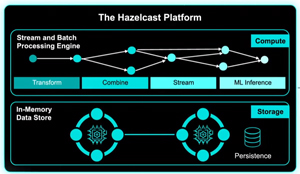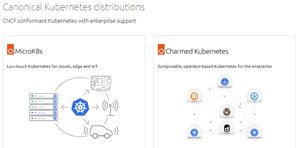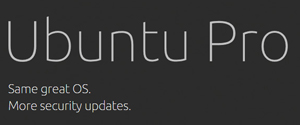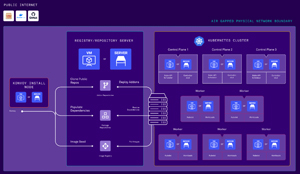Take Five With Tom Fenton
Tom's Takes on KubeCon North America 2022
Tom Fenton looks at companies he found especially interesting this year.
Cloud Native Computing Foundation's (CNCF) flagship Kubernetes (K8s) conference, KubeCon + CloudNativeCon (KubeCon), was held as a live and virtual event Oct. 24-28, 2022, in Detroit. The live event had 8,000 attendees, and the virtual event had another 8,000 registrants.
In addition to having the chance to connect with fellow attendees, one of the things that I really enjoy about these shows is the ability to sit down with vendors, and at KubeCon 2022 I had the opportunity to talk to several. In this article, I will look at companies that I found especially interesting this year.
Hazelcast -- Self-described as "a streaming and memory-first application platform for fast, stateful, data-intensive workloads on-premises, at the edge or as a fully managed cloud service," Hazelcast was founded in 2008, and has been on a tear recently with a projected 35 percent ARR growth this year. This platform is used by many Fortune 500 companies in diverse fields, such as autonomous vehicles and remote drilling operations, where its ability to stream data at the edge at incredible speeds enables the technologies that they depend on.
 [Click on image for larger view.]
[Click on image for larger view.]
In my discussion with Manish Devgan, chief product officer at Hazelcast, he described various use cases for Hazelcast, including applying a fraud detection algorithm against customer data sitting on its old relational database platform, as well as real-time data aggregation to make complex decisions on control and balance of supply for traditional and off-grid sources of energy. This latter application of Hazelcast resulted in a system that was 1,200 percent faster and sped up data insight times from two hours to 10 minutes for the company.
Canonical -- Best known for Ubuntu, Canonical was an early adopter of K8s, and they currently support MicroK8s (low-touch K8s for clouds, edge and IoT) and Charmed Kubernetes (composable, operator-based K8s for enterprise use). It was good to see them at the show and have a chance to catch up with them.
 [Click on image for larger view.]
[Click on image for larger view.]
Right before KubeCon, Canonical made an announcement that caught my eye -- free personal Ubuntu Pro subscriptions. Ubuntu has always been a leader in providing security coverage for their Linux distribution, and Ubuntu Pro expands this 10-year security coverage to include an additional 23,000 packages beyond their core OS. Some of the packages and products it covers include: Ansible, Apache Tomcat, Apache Zookeeper, Docker, Drupal, Nagios, Node.js, phpMyAdmin, Puppet, PowerDNS, Python 2, Redis, Rust and WordPress.
 [Click on image for larger view.]
[Click on image for larger view.]
As this is a free service for personal and small-scale commercial deployment, it is limited to five machines. Users can obtain a free personal Ubuntu Pro subscription at ubuntu.com/pro.
Canonical made a few other exciting announcements, including Strictly Confined MicroK8s. This is a snap confinement level that provides complete isolation, up to a minimal access level that's always deemed safe. Strictly confined snaps cannot access files, networks, processes or any other system resource without requesting specific access. ClusterAPI provisioning enables MicroK8s to be deployed on any infrastructure provider supported by ClusterAPI
D2iQ -- While much of the focus on K8s pertains to initial deployment, one of the really big challenges relates to the day-to-day monitoring and maintenance, or day 2, of production deployments of K8s. This is especially challenging in multi-cloud environments. When I met with D2iQ, they discussed their recently released product, DKP 2.3, which simplifies the process of managing AWS EKS clusters while also supporting K8s provisioning on the top-three public cloud providers -- Amazon Web Services (AWS), Microsoft Azure and Google Cloud Platform -- each of which has its own K8s distributions: AWS EKS, Azure Kubernetes Service (AKS) and Google Kubernetes Engine (GKE), respectively. DKP supports these as well all from a single portal.
Two of the more interesting side notes I found out about D2iQ in our discussion was that they were the company behind Mesosphere. Mesosphere was an early, and very hot, entrant in the container orchestration field. The other thing that I found remarkable is that they can deploy K8s in an air-gapped environment. This is huge for those companies/governmental agencies that demand the highest level of security.
 [Click on image for larger view.]
[Click on image for larger view.]
Pure Storage -- At KubeCon 2020, Pure Storage, a leader in all-flash storage, announced that they had acquired Portworx, a leader in container storage, for $370 million. This acquisition was a big deal, and I was interested to see if Pure could capitalize on the presence that Portworx has in the K8s community and become a major player in the increasingly crowded container storage field.
Kasten -- Another acquisition announced at KubeCon 2020 was the longtime and much-respected backup and recovery expert company Veeam acquiring Kasten, a leader in K8s. By all accounts, Veeam has taken a very hands-off approach to Kasten; in fact, I couldn't even find a link to Kasten on Veeam's web site, and Kasten just has small nod to Veeam on theirs.
 [Click on image for larger view.]
[Click on image for larger view.]
At this year's KubeCon, Kasten took the opportunity to announce K10 V5.5 and its new capabilities. It has Intelligent Policies that make it easier to protect data at the scale that K8s is capable of by factoring in the non-peak usage for the backup window and automation of the underlying backup jobs. They have expanded cloud-native ecosystems to support Red Hat OpenShift container and virtual machine workloads, Kubernetes 1.23, Azure File Share as a backup target, Azure Managed Identity and additional regions including AWS (Jakarta) and GCP (Milan). To help in the deployment and scaling capabilities of these new features, K10 V5.5 has an intuitive graphical wizard to generate the most suitable install manifests that can be visualized and repeated for multiple installs.
PostgreSQL -- This free open source relational database management system company was founded in 1996, and has since become widely used and respected by companies both big and small. CloudNativePG is their open-source K8s operator that manages highly available primary/standby cluster architectures for the Postgres database management system. At KubeCon, Gabriele Bartolini and Chris Milsted hosted a session on their cloud-native PostgreSQL operator and how to use it with a CSI-plugin to deliver the PostgreSQL databases.
 [Click on image for larger view.]
[Click on image for larger view.]
Red Hat -- Red Hat made a few very interesting announcements at KubeCon, including Red Hat Device Edge, which should GA in 2023. This is an enterprise-ready and supported distribution of Red Hat's open source community project, MicroShift, an edge-optimized OS built from Red Hat Enterprise Linux. MicroShift is a lightweight K8s orchestration solution built with its roots in Red Hat OpenShift. It is designed to allow flexible deployment of traditional or containerized workloads on small devices such as robots, IoT gateways or points of sale.
Red Hat announced that it has partnered with Intel to open new hands-on labs and testing environments in North America, Asia Pacific and Europe for edge innovations. The newly opened facilities bring together customers and partners of Red Hat and Intel to co-develop integrated solutions for edge, 5G, AI/ML and industrial use cases.
 [Click on image for larger view.]
[Click on image for larger view.]
SUSE -- This is a company going in deep on the edge. They've released Edge 2.0, a fully integrated cloud-native solution to manage K8s and the OS at the edge. Now, they've released SUSE Linux Enterprise (SLE) Micro 5.3, a lightweight OS purposely built for containerized and virtualized workloads. It is fully integrated with Rancher, which they acquired a while ago. This allows SUSE to manage OSes and K8s from a single dashboard regardless of if they are running on bare metal, virtually or in the cloud.
 [Click on image for larger view.]
[Click on image for larger view.]
Three years ago, I predicted that a considerable consolidation would take place in the K8s space -- at KubeCon 2022, we are starting to see the fruits of that consolidation. Although I have just highlighted a few of those instances, there were many, many more that took place. I am glad to see that, for the most part, it has been a win-win for both the acquirees and the acquired. Despite the consolidations that have taken place, however, it seems like with every company that has gone away, two or three others have popped up with new and exciting technologies to offer within the K8s space.